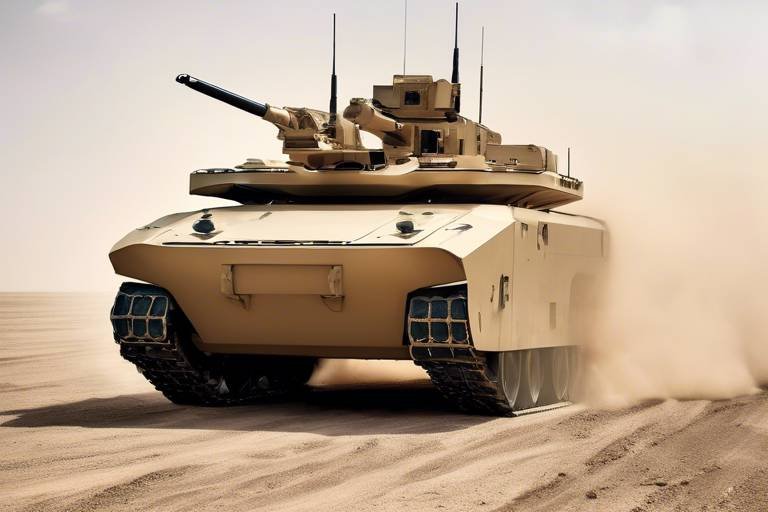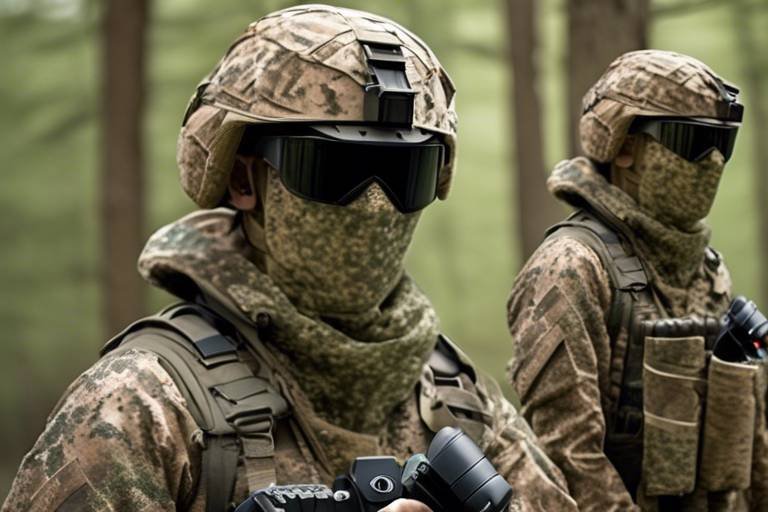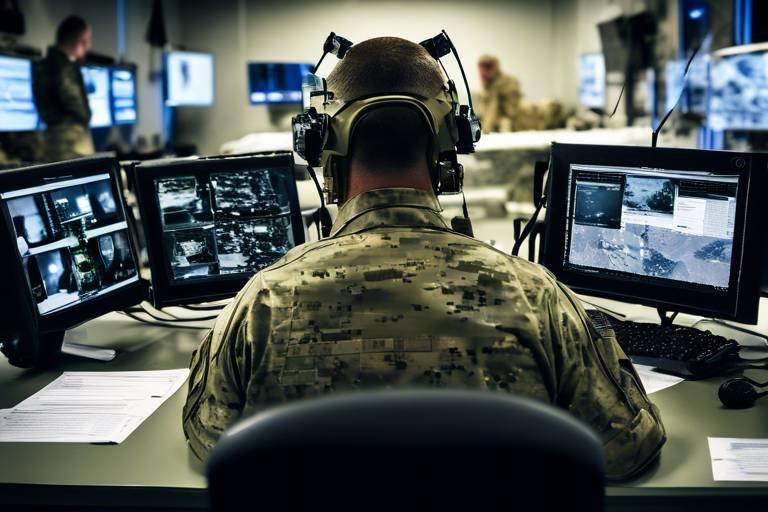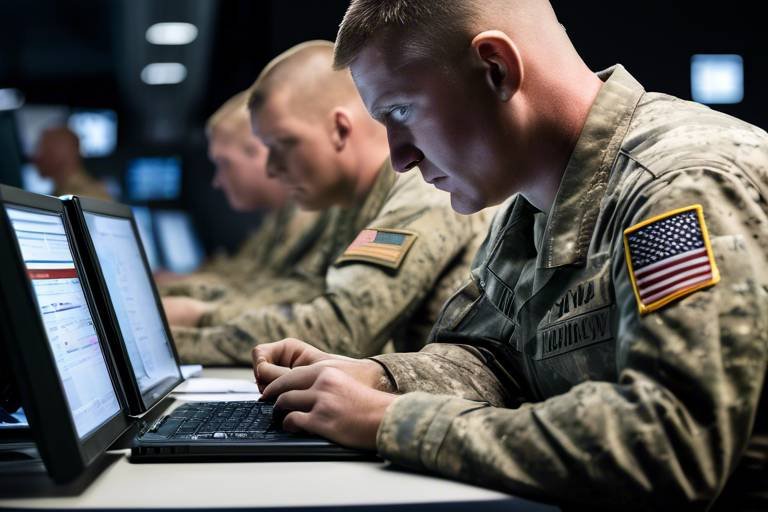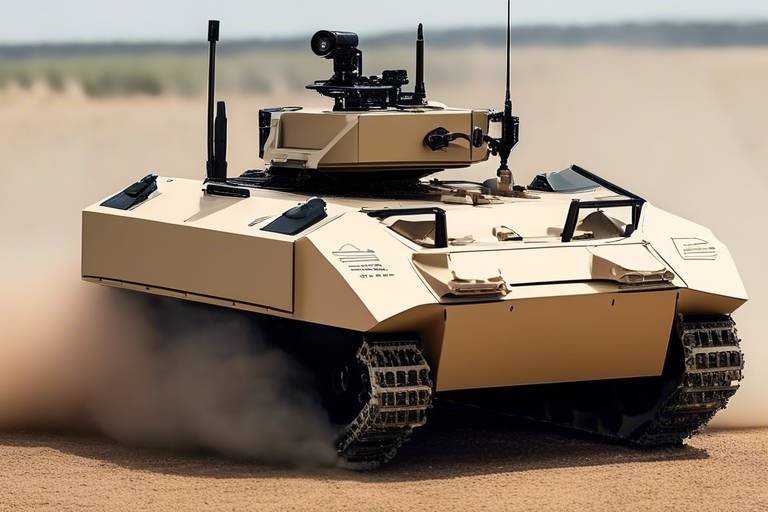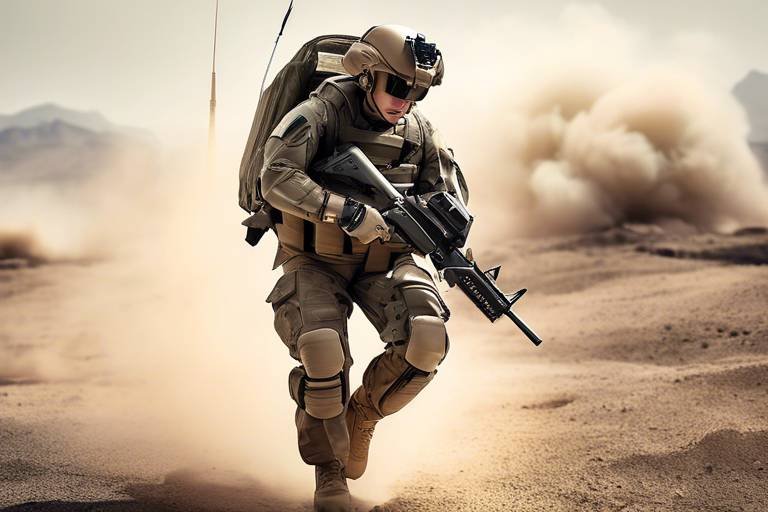Military Robotics - The New Age of Combat
The landscape of warfare is undergoing a seismic shift, and at the forefront of this transformation are military robotics. As we stand on the brink of a new era, these technological marvels are not just futuristic concepts; they are actively reshaping how conflicts are fought and won. From unmanned aerial vehicles (UAVs) soaring high above the battlefield to ground robots navigating treacherous terrains, military robotics are enhancing operational capabilities and redefining strategies in ways we could only imagine a few decades ago.
Imagine a battlefield where soldiers are no longer the primary targets. Instead, they can command robots that take on the most dangerous missions, from surveillance to combat. This is not science fiction; it is the reality of modern military operations. The evolution of robotics in the military sphere is marked by significant advancements that have made these machines indispensable. The journey began with rudimentary remote-controlled devices, but today, we are witnessing sophisticated systems capable of autonomous decision-making, advanced surveillance, and precision strikes.
As we delve deeper into this topic, we will explore how military robotics have evolved, the various types of robots currently in use, and the profound advantages they offer. However, with great power comes great responsibility. The integration of robotics into military operations also raises critical ethical questions about accountability and the implications of autonomous warfare. In this article, we will navigate through these complexities, providing insights into both the potential and the challenges of military robotics.
The history of military robotics is as fascinating as it is complex. It began during World War II when rudimentary forms of automation were introduced, but the real revolution kicked off in the late 20th century with the advent of computers and advanced sensors. Each decade has brought remarkable breakthroughs:
- 1970s-1980s: Early experiments with drones for reconnaissance.
- 1990s: The introduction of UAVs like the Predator, which began to change surveillance tactics.
- 2000s: The rise of combat drones and ground robots, enhancing operational capabilities.
- 2010s-Present: Advanced AI integration, allowing for autonomous decision-making.
These milestones illustrate not just technological progress but also a shift in military doctrine, where robots are becoming integral to modern warfare strategies. The evolution of military robotics signifies a move towards more efficient, precise, and less risky operations, allowing militaries to adapt to new threats and challenges.
Military robots can be categorized into several types, each serving unique purposes that enhance overall operational effectiveness. The primary categories include:
UAVs have become synonymous with modern military operations. These flying robots are not just for show; they are equipped with cutting-edge technology that enables them to perform various critical functions:
UAVs play an essential role in gathering intelligence. They provide real-time data that enhances situational awareness, allowing commanders to make informed decisions quickly. Imagine having eyes in the sky that can monitor enemy movements without putting soldiers at risk. This capability dramatically improves the effectiveness of military operations.
Combat drones, such as the MQ-9 Reaper, have revolutionized targeted strikes. These drones can carry out precision attacks with minimal collateral damage, reducing the risk to personnel while achieving operational objectives. The ability to strike from a distance means that military forces can engage in combat without exposing themselves to enemy fire, a game-changer in warfare.
Ground robots are equally impressive, serving various functions such as bomb disposal, logistics support, and reconnaissance missions. These machines enhance safety by taking on dangerous tasks that would otherwise put soldiers at risk. For instance, bomb disposal robots are equipped with advanced sensors and tools to neutralize explosives, ensuring that human lives are preserved.
Integrating robotics into military strategies offers numerous advantages that enhance overall effectiveness:
The most significant benefit of military robotics is the reduction of risk to personnel. By deploying robots in dangerous situations, military forces can minimize human casualties. This not only preserves lives but also boosts morale among troops, knowing that they have advanced technology supporting them in the field.
Robotics streamline military operations, improving response times and resource allocation. With robots handling routine tasks, human soldiers can focus on strategic decision-making and complex problem-solving. This efficiency is crucial in high-pressure environments where every second counts.
As we embrace the future of military robotics, we must also confront the ethical dilemmas they present. The integration of autonomous systems raises questions about accountability and the morality of machines making life-and-death decisions.
One of the most pressing issues is determining who is responsible for the actions taken by autonomous military robots. As these machines operate with increasing independence, the lines of accountability blur. This situation has significant implications for international law and military ethics.
Another ethical concern is the capacity for autonomous systems to make lethal decisions without human intervention. This raises profound questions about the morality of allowing machines to determine life and death in combat situations. The lack of human oversight can lead to unintended consequences, making it essential to establish clear guidelines and frameworks for the use of military robotics.
- What are military robots primarily used for? Military robots are used for surveillance, reconnaissance, bomb disposal, logistics, and combat operations.
- How do UAVs enhance military operations? UAVs provide real-time intelligence, conduct precision strikes, and reduce the risk to personnel.
- What ethical concerns are associated with military robotics? Key concerns include accountability for actions taken by robots and the morality of autonomous decision-making in warfare.
- Are military robots replacing human soldiers? While robots enhance military capabilities, they are not intended to replace human soldiers but rather to assist them in dangerous tasks.

Evolution of Military Robotics
The evolution of military robotics is nothing short of a technological revolution that has redefined the landscape of modern warfare. From the early days of rudimentary machines to today's sophisticated autonomous systems, military robotics has undergone significant transformations that reflect advancements in technology and changes in combat strategy. Initially, military robots were simple devices, often used for basic tasks such as reconnaissance and surveillance. However, as technology progressed, so did the complexity and capability of these machines.
One of the pivotal moments in the evolution of military robotics came during the Cold War. The arms race prompted nations to invest heavily in technological advancements, leading to the development of early drones and unmanned systems. These machines were primarily used for intelligence-gathering missions, allowing military forces to monitor enemy movements without putting personnel at risk. The introduction of unmanned aerial vehicles (UAVs) marked a significant leap forward, as they provided real-time data that enhanced situational awareness on the battlefield.
Fast forward to the 21st century, and we see a proliferation of various types of military robots, each designed to fulfill specific roles. The integration of artificial intelligence (AI) and machine learning has enabled these robots to operate with greater autonomy, making them invaluable assets in combat operations. For instance, ground robots are now capable of performing complex tasks such as bomb disposal, logistics support, and reconnaissance missions, significantly reducing the risk to human soldiers.
Moreover, the use of combat drones has transformed how military forces engage in warfare. These drones are equipped with advanced targeting systems and can carry out precision strikes with minimal collateral damage. The evolution of military robotics has not only improved operational efficiency but has also raised important questions about the future of warfare, ethics, and accountability.
As we look to the future, the evolution of military robotics continues to unfold. With ongoing advancements in technology, we can expect even more sophisticated systems that can operate in complex environments, adapt to changing conditions, and make decisions in real-time. The integration of robotics into military operations is not merely a trend; it represents a fundamental shift in how wars are fought and won.
- What are military robots used for? Military robots are used for various purposes, including surveillance, reconnaissance, logistics support, and combat operations.
- How have military robots changed warfare? They have enhanced operational efficiency, reduced risks to personnel, and enabled more precise targeting in combat scenarios.
- What ethical concerns are associated with military robotics? Ethical concerns include accountability for autonomous actions, decision-making in lethal scenarios, and the potential for misuse of technology.

Types of Military Robots
The landscape of modern warfare has been dramatically reshaped by the introduction of various types of military robots. These advanced machines are not just tools; they are pivotal players in the battlefield, each designed for specific roles that enhance military effectiveness. From the skies to the ground and even beneath the waves, military robots come in several forms, including Unmanned Aerial Vehicles (UAVs), Ground Robots, and Naval Drones. Each type has its own unique functionalities, contributing to a more efficient and strategic approach to combat.
Unmanned Aerial Vehicles (UAVs), commonly known as drones, have revolutionized the way intelligence is gathered and operations are conducted. These flying machines provide real-time surveillance, reconnaissance, and even targeted strikes, all while keeping human operators safely away from danger. The versatility of UAVs allows them to be deployed in various scenarios, from monitoring enemy movements to delivering precision strikes on high-value targets. Their ability to operate in hostile environments without risking pilot lives is a game changer.
Among UAVs, we can distinguish two primary functions:
- Surveillance and Reconnaissance: UAVs equipped with advanced sensors and cameras can gather intelligence that is crucial for mission planning. They enhance situational awareness by providing commanders with live feeds and data analysis, allowing for better-informed decisions on the battlefield.
- Combat Drones: These UAVs are armed and designed for offensive operations. They can engage targets with remarkable precision, significantly reducing the risk to human soldiers. The effectiveness of combat drones in executing strikes has been proven in various conflicts, showcasing their capability to achieve operational objectives with minimal collateral damage.
Ground robots, on the other hand, play a different but equally vital role in military operations. These machines are often used for tasks that are too dangerous for human soldiers, such as bomb disposal, logistics, and reconnaissance missions. For instance, bomb disposal robots can safely neutralize explosive devices, thus saving lives and ensuring mission success. Additionally, logistical robots can transport supplies and equipment, enhancing the efficiency of military operations.
Finally, we have Naval Drones, which are becoming increasingly important in maritime warfare. These drones can operate above and below the water, performing surveillance, reconnaissance, and even engaging in combat. Their ability to gather intelligence in challenging environments makes them invaluable assets in maintaining maritime security.
As we continue to integrate these various types of military robots into defense strategies, it’s important to recognize their contributions to modern warfare. The evolution of military robotics is not just a technological advancement; it represents a fundamental shift in how wars are fought and won. Each type of robot brings unique strengths and capabilities, ensuring that military forces can adapt to the ever-changing landscape of combat.
- What are the main types of military robots?
The main types include Unmanned Aerial Vehicles (UAVs), Ground Robots, and Naval Drones, each serving distinct roles in military operations. - How do UAVs enhance military operations?
UAVs provide real-time surveillance and reconnaissance while also executing precision strikes, significantly reducing risks to human personnel. - What roles do ground robots play?
Ground robots are primarily used for bomb disposal, logistics support, and reconnaissance, allowing for safer and more efficient operations. - Are there ethical concerns regarding military robotics?
Yes, there are significant ethical implications, including accountability for autonomous actions and the morality of machines making life-and-death decisions.
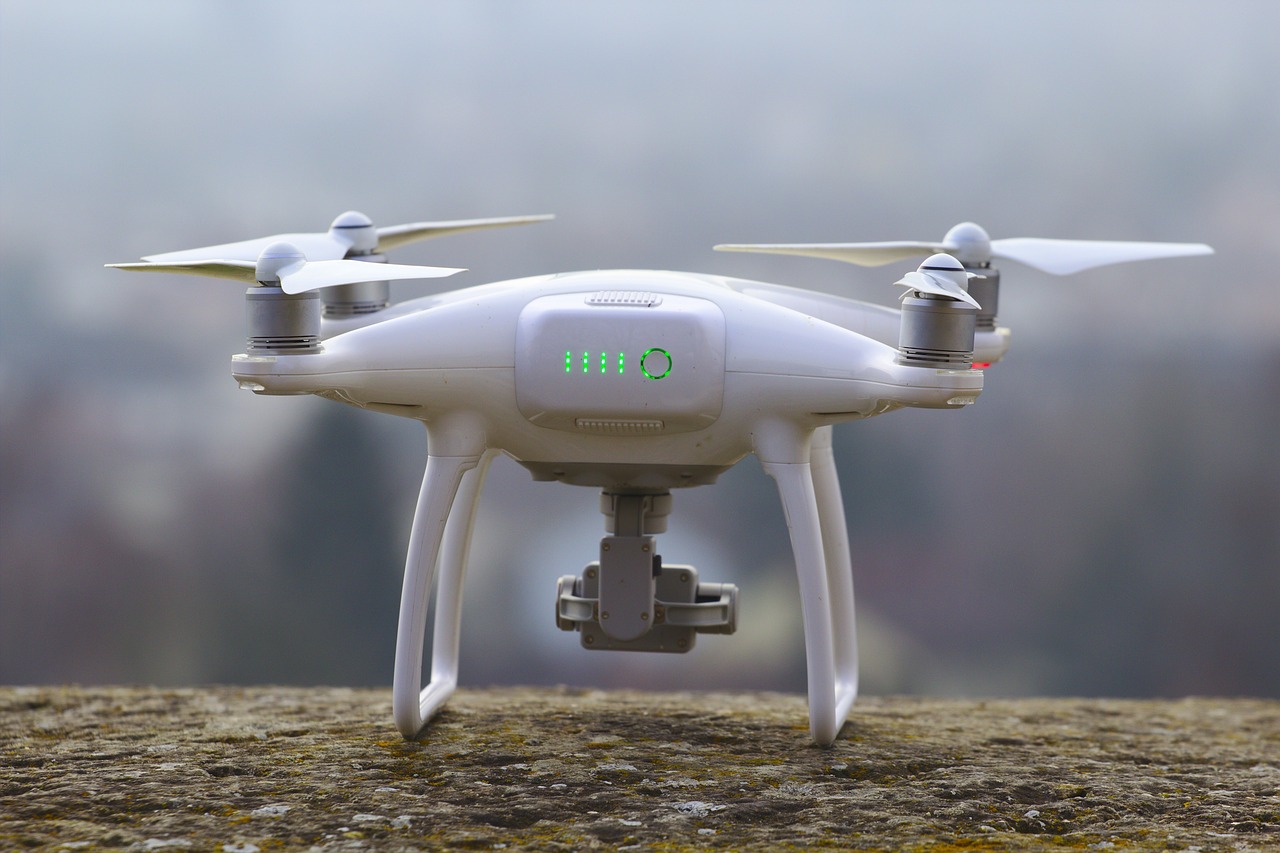
Unmanned Aerial Vehicles (UAVs)
Unmanned Aerial Vehicles, commonly known as UAVs or drones, have become a game-changer in modern warfare. These sophisticated machines are not just flying cameras; they are powerful tools equipped with advanced technologies that allow for a variety of military applications. From surveillance to combat missions, UAVs have revolutionized how military operations are conducted. Imagine having the ability to gather real-time intelligence without putting a single soldier in harm's way. That’s the magic of UAVs!
One of the key advantages of UAVs is their capability to perform surveillance and reconnaissance missions. These aerial platforms can fly high above the battlefield, offering a bird’s-eye view that enhances situational awareness for military commanders. Equipped with high-resolution cameras and sensors, UAVs can capture detailed images and data, allowing for informed decision-making. For instance, during operations in hostile territories, UAVs can monitor enemy movements and gather intelligence without being detected, thus providing a strategic advantage.
Moreover, UAVs are not limited to reconnaissance; they also play a crucial role in combat operations. Combat drones are designed specifically for precision strikes, minimizing collateral damage while effectively neutralizing threats. This capability significantly reduces the risk to personnel, as these drones can engage targets from a safe distance. For example, a combat drone can carry out an airstrike on a high-value target while the operator remains thousands of miles away, ensuring that soldiers are kept out of harm's reach.
In addition to their tactical advantages, UAVs also enhance operational efficiency. The integration of UAVs into military strategies allows for real-time data dissemination, enabling faster response times and more effective resource allocation. When commanders have access to up-to-the-minute intelligence, they can make quicker and more accurate decisions, ultimately leading to mission success. This capability is especially critical in complex combat environments where the fog of war can obscure the battlefield.
However, the use of UAVs is not without its challenges. As these technologies continue to evolve, so do the ethical questions surrounding their deployment. Issues such as accountability and autonomous decision-making need to be addressed to ensure that UAVs are used responsibly and ethically in combat scenarios. The balance between leveraging advanced technology for military advantage and adhering to moral standards is a delicate one, and ongoing discussions are crucial as we move forward.
- What are UAVs used for in the military? UAVs are primarily used for surveillance, reconnaissance, and combat operations, allowing for real-time intelligence gathering and precision strikes.
- How do UAVs enhance military operations? UAVs provide a bird's-eye view of the battlefield, improve situational awareness, and reduce the risk to personnel by allowing for remote engagement of targets.
- Are there ethical concerns related to the use of UAVs? Yes, ethical concerns include accountability for actions taken by drones and the implications of autonomous decision-making in lethal scenarios.
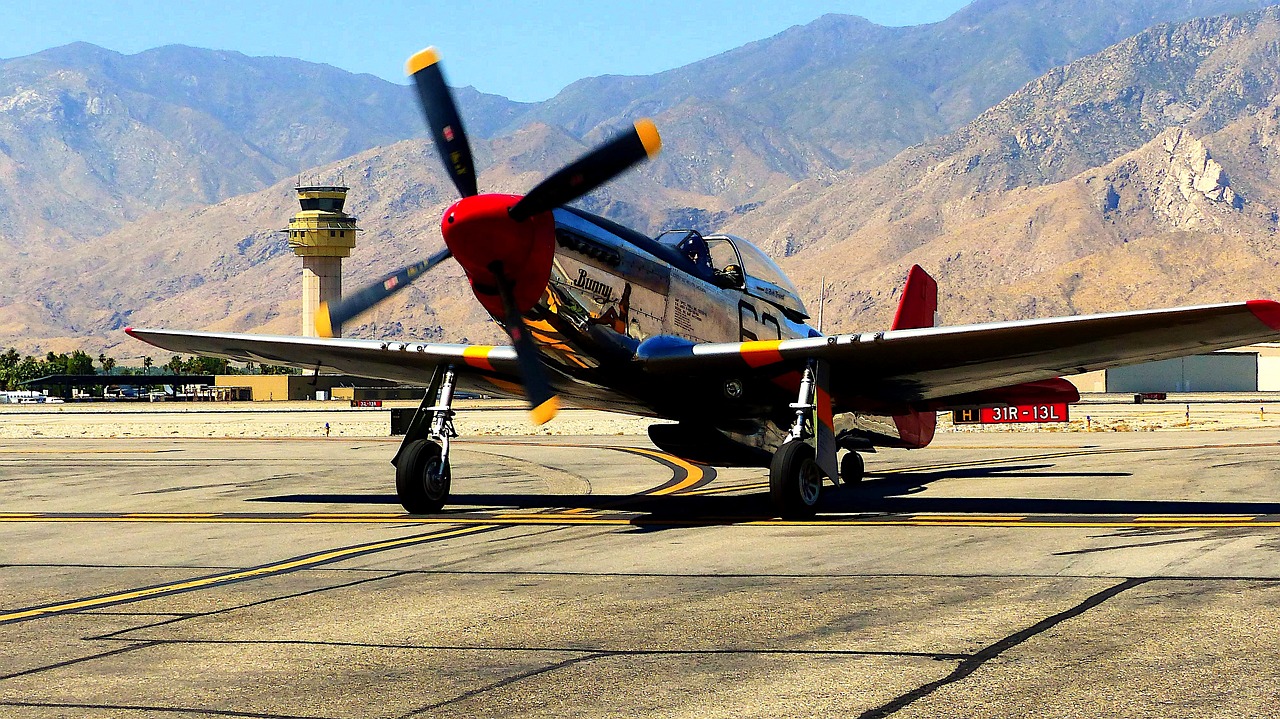
Surveillance and Reconnaissance
In the ever-evolving landscape of modern warfare, unmanned aerial vehicles (UAVs) have emerged as game-changers, particularly in the realms of surveillance and reconnaissance. Imagine a bird's-eye view of the battlefield, where every movement is monitored, every decision is informed, and every second counts. UAVs are equipped with advanced sensors and cameras, enabling them to gather vast amounts of intelligence without putting human lives at risk. This capability has not only enhanced situational awareness but has also transformed the way military operations are planned and executed.
One of the most significant advantages of UAVs in surveillance is their ability to cover large areas quickly and efficiently. Unlike traditional reconnaissance methods, which often involve manned aircraft or ground troops, UAVs can loiter over a designated area for extended periods, collecting data and transmitting it in real-time. This constant flow of information allows commanders to make informed decisions based on the most current intelligence available. For instance, during a conflict, a UAV can provide live feeds of enemy movements, troop concentrations, and even changes in terrain, which can be crucial for mission success.
The technology behind these UAVs is nothing short of remarkable. With features like high-resolution cameras, infrared sensors, and radar systems, they can operate effectively in various conditions, whether it's day or night, clear skies or inclement weather. The integration of artificial intelligence (AI) further enhances their capabilities, allowing for automated target recognition and tracking. This means that UAVs can identify potential threats and relay that information back to commanders without human intervention, significantly speeding up the decision-making process.
Moreover, the use of UAVs in surveillance and reconnaissance has led to a paradigm shift in military strategy. Instead of relying solely on ground troops to gather intelligence, militaries can deploy UAVs to perform these tasks, thereby reducing the risk to personnel. This not only preserves the lives of soldiers but also allows them to focus on executing their missions rather than gathering intelligence. The operational efficiency gained through UAV surveillance is staggering, allowing for more effective resource allocation and mission planning.
However, the integration of UAVs into military operations is not without its challenges. As they become more prevalent, questions arise regarding the ethical implications of their use. For instance, what happens when surveillance data is misused? Who is accountable if a UAV inadvertently causes civilian casualties during a reconnaissance mission? These are critical questions that military leaders and policymakers must address as they navigate the complexities of modern warfare.
In conclusion, UAVs have revolutionized the fields of surveillance and reconnaissance, providing militaries with unprecedented capabilities to gather intelligence and make informed decisions on the battlefield. As technology continues to advance, the role of UAVs in military operations will likely expand, further shaping the future of warfare.
- What are UAVs used for in military operations? UAVs are primarily used for surveillance, reconnaissance, and targeted strikes, providing real-time intelligence and reducing risks to personnel.
- How do UAVs enhance situational awareness? They gather and transmit vast amounts of data on enemy movements and terrain, allowing commanders to make informed decisions quickly.
- What ethical concerns are associated with UAV surveillance? Issues of accountability, potential civilian casualties, and the misuse of surveillance data are significant ethical considerations in military operations.
- Can UAVs operate in adverse weather conditions? Yes, many UAVs are equipped with advanced sensors that allow them to operate effectively in various weather conditions, including low visibility.
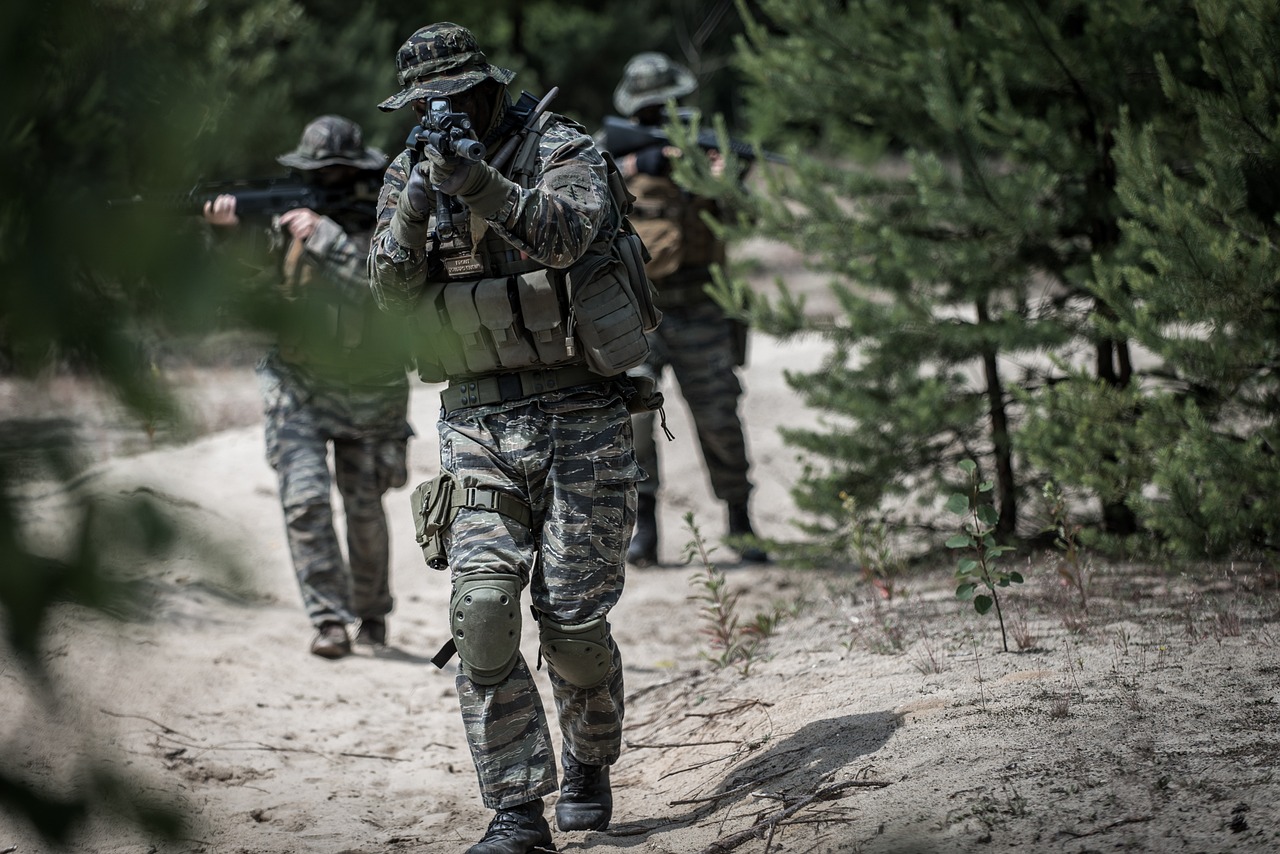
Combat Drones
Combat drones, often referred to as unmanned combat aerial vehicles (UCAVs), have transformed the landscape of modern warfare. These advanced machines are more than just flying robots; they represent a significant leap in military technology, providing capabilities that were once the stuff of science fiction. Imagine a battlefield where decisions can be made in real-time, with precision strikes executed without putting human lives at risk. Sounds incredible, right? Well, that's the reality combat drones bring to the table.
One of the most significant advantages of combat drones is their ability to conduct precision strikes. Unlike traditional airstrikes that can result in collateral damage, drones can be equipped with advanced targeting systems that allow for pinpoint accuracy. This precision minimizes civilian casualties and enhances mission success rates, which is crucial in today's politically sensitive environment. For instance, when a combat drone is deployed, it can hover over a target area for hours, providing real-time intelligence and waiting for the perfect moment to strike. This capability not only allows for strategic planning but also ensures that the right target is hit at the right time.
Moreover, combat drones can operate in environments that are too dangerous for manned aircraft. They can fly at high altitudes and remain undetected, making them ideal for surveillance and reconnaissance missions. With their ability to gather intelligence without putting pilots at risk, these drones have become invaluable assets in military operations. They can monitor enemy movements, assess battlefield conditions, and provide commanders with critical information, all while keeping a safe distance from the action.
Another fascinating aspect of combat drones is their cost-effectiveness. Compared to traditional fighter jets, drones are significantly cheaper to produce and maintain. This affordability allows military forces to deploy multiple drones for various missions, increasing their operational capabilities without breaking the bank. Additionally, the training required for drone operators is less intensive than that for piloting manned aircraft, which further reduces costs and time.
However, the use of combat drones is not without its controversies. The ethical implications of using unmanned systems to make life-and-death decisions have sparked intense debates. Questions arise about accountability and the potential for misuse. Who is responsible when a drone strike results in unintended casualties? The operator? The commanding officer? Or the manufacturer? These are complex issues that military and political leaders must navigate as they integrate drones into their strategies.
In conclusion, combat drones represent a revolution in warfare, offering unprecedented advantages in terms of precision, safety, and cost. As technology continues to evolve, the role of these unmanned systems will likely expand, further shaping the future of military operations. However, it is essential to approach their use with caution, ensuring that ethical considerations are at the forefront of their deployment.
- What are combat drones?
Combat drones, or unmanned combat aerial vehicles (UCAVs), are unmanned aircraft used for military operations, including surveillance and precision strikes. - How do combat drones enhance military operations?
They provide real-time intelligence, execute precision strikes with minimal collateral damage, and operate in environments that are too dangerous for manned aircraft. - What are the ethical concerns surrounding combat drones?
Issues include accountability for strikes that result in civilian casualties and the moral implications of allowing machines to make life-and-death decisions. - Are combat drones cost-effective?
Yes, they are generally cheaper to produce and maintain than traditional fighter jets, allowing for greater deployment and operational flexibility.
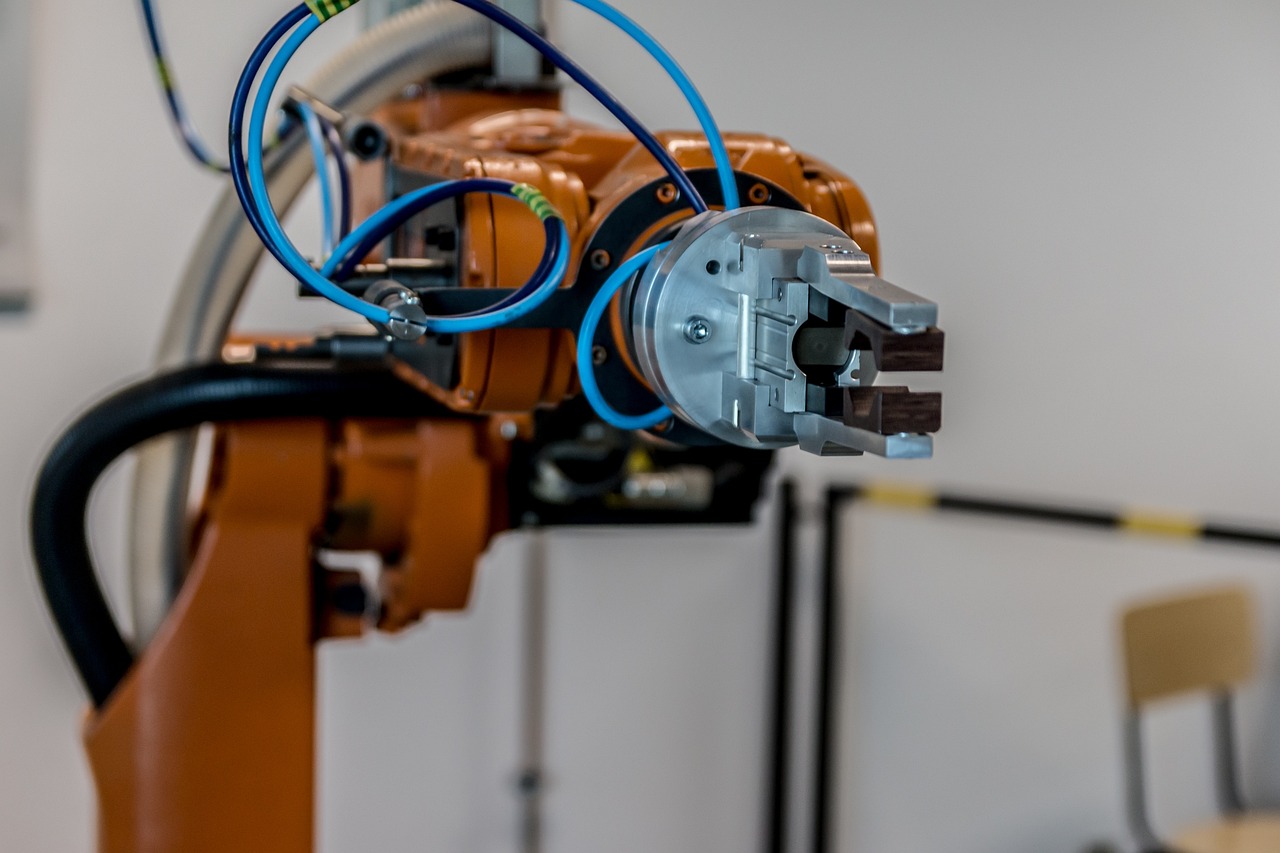
Ground Robots
Ground robots have emerged as a transformative force in modern military operations, redefining how tasks are executed on the battlefield. These machines, often equipped with advanced sensors and artificial intelligence, serve multiple roles that enhance both safety and effectiveness. Imagine a soldier sending in a robot to investigate a suspicious object instead of risking their own life; this is the new reality of warfare. Ground robots are not just tools; they are integral team members that can perform various functions, from bomb disposal to logistics support.
One of the most significant advantages of ground robots is their ability to handle hazardous situations that would otherwise endanger human lives. For instance, bomb disposal robots are specifically designed to safely defuse explosives, allowing military personnel to maintain a safe distance while ensuring the threat is neutralized. These robots are equipped with robotic arms and cameras, enabling them to manipulate objects and provide real-time video feeds to operators. This technology not only protects soldiers but also increases the likelihood of mission success.
In addition to bomb disposal, ground robots are also utilized for reconnaissance missions. They can traverse difficult terrains where humans might struggle, gathering crucial intelligence without putting anyone in harm's way. Equipped with high-resolution cameras and various sensors, these robots can scout enemy positions, monitor terrain changes, and provide detailed reports back to command centers. The data collected can be pivotal in shaping military strategies, ensuring that commanders have the most accurate information at their disposal.
Moreover, logistics is another area where ground robots shine. They can transport supplies, ammunition, and equipment across the battlefield, significantly improving the efficiency of logistical operations. By automating these tasks, military forces can allocate their human resources to more critical areas, thus enhancing overall operational effectiveness. Picture a convoy of robots delivering essential supplies to troops in the field while keeping them safe from enemy fire—this is the future of military logistics.
However, the integration of ground robots into military operations does raise some questions. As these machines become more autonomous, issues surrounding their use and the ethical implications of deploying them in combat scenarios need to be addressed. Who is responsible if a ground robot makes a mistake? How do we ensure that these machines are used ethically and effectively? These are crucial considerations that military leaders must grapple with as they embrace this new technology.
In conclusion, ground robots represent a significant advancement in military technology, offering numerous benefits that enhance the safety and efficiency of operations. Their ability to perform dangerous tasks, gather intelligence, and streamline logistics makes them invaluable assets on the battlefield. As we continue to innovate and integrate these technologies, it is essential to maintain a focus on the ethical implications and ensure that they are used responsibly in the pursuit of peace and security.
- What are the primary functions of ground robots in the military? Ground robots are primarily used for bomb disposal, reconnaissance, and logistics support, helping to keep soldiers safe while enhancing operational efficiency.
- How do ground robots enhance safety for military personnel? By taking on hazardous tasks, ground robots minimize the risk to human lives, allowing soldiers to maintain a safe distance from potential threats.
- Are ground robots autonomous? Many ground robots are equipped with varying degrees of autonomy, allowing them to perform tasks with minimal human intervention, although ethical considerations regarding their use are still being discussed.
- What ethical concerns are associated with military ground robots? Key ethical concerns include accountability for mistakes made by autonomous robots and the implications of using machines to make life-and-death decisions in combat situations.
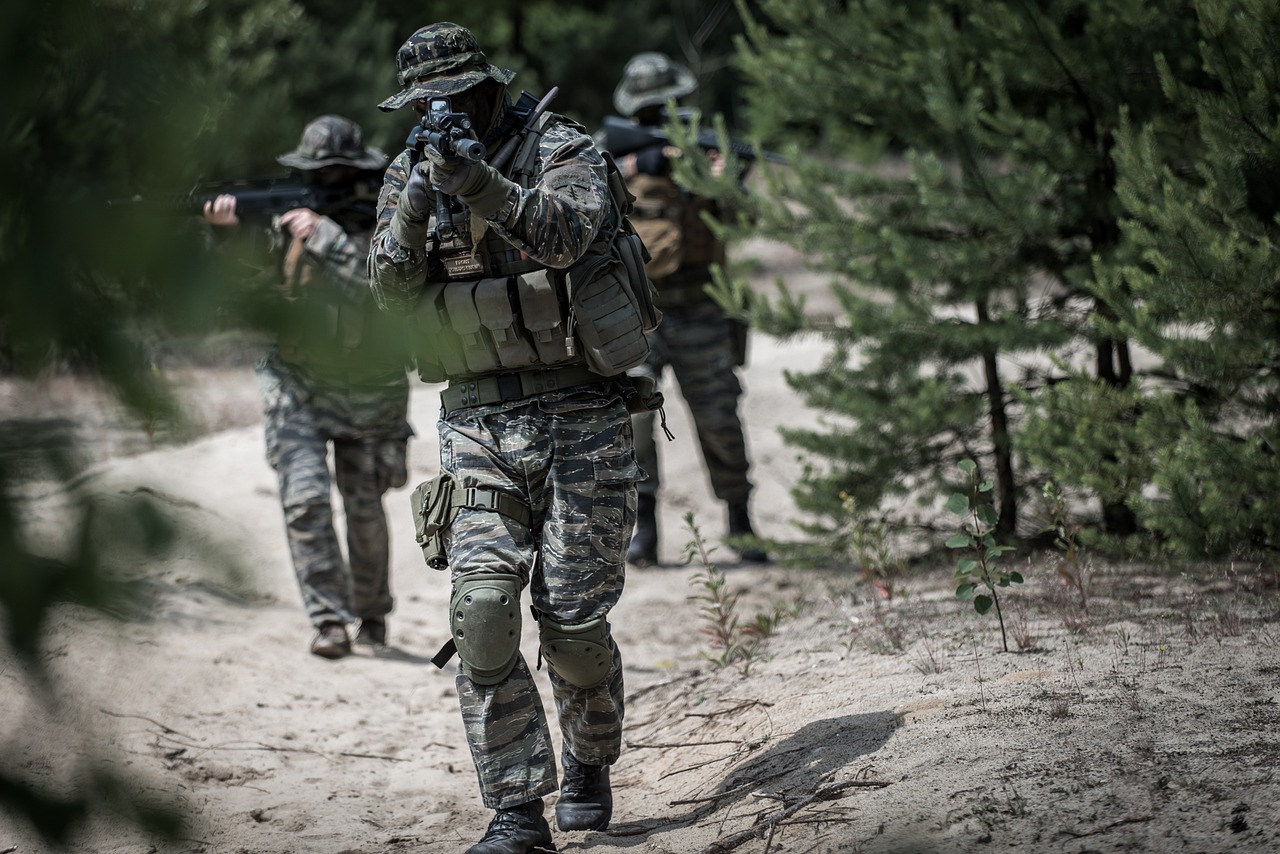
Advantages of Military Robotics
Military robotics have revolutionized the way armed forces operate, bringing a host of advantages that significantly enhance their capabilities. One of the most compelling benefits is the increased efficiency that these robotic systems provide. Imagine a battlefield where decisions are made faster, logistics are streamlined, and operations can be executed with pinpoint accuracy. This is not just a dream; it's a reality made possible through the integration of robotics into military strategies.
Another critical advantage is the reduction of human risk. In combat scenarios, soldiers are often exposed to life-threatening situations. By deploying robots to handle dangerous tasks, such as bomb disposal or reconnaissance in hostile environments, military forces can preserve the lives of their personnel. For instance, a ground robot can be sent to defuse an explosive device, thereby ensuring that no human lives are put at risk during this perilous operation. This not only enhances mission success rates but also boosts morale within the ranks, knowing that their safety is prioritized.
Moreover, military robotics enhance operational capabilities in complex combat environments. These machines can operate in conditions that would be perilous for humans, such as extreme weather or areas with high radiation levels. For example, drones can conduct surveillance in environments that are too dangerous for manned aircraft, providing crucial intelligence without endangering lives. This capability allows military leaders to make informed decisions based on real-time data, ultimately leading to more effective strategies.
Consider the following table that summarizes some key advantages of military robotics:
| Advantage | Description |
|---|---|
| Increased Efficiency | Robotics streamline processes, improving response times and resource allocation. |
| Reduced Human Risk | Minimizes casualties by taking on dangerous tasks traditionally performed by soldiers. |
| Enhanced Operational Capabilities | Allows operations in extreme conditions, providing critical intelligence without human risk. |
In addition to these advantages, the integration of robotics into military operations also leads to better resource management. Robots can be deployed in a variety of roles, from logistics to direct combat support, allowing for a more versatile and adaptable force. This flexibility means that military planners can allocate resources more efficiently, ensuring that the right tools are in the right places when they are needed most.
As we look to the future, the potential for military robotics continues to grow. With advancements in artificial intelligence and machine learning, these systems are becoming increasingly sophisticated. They can learn from their environments, adapt to changing conditions, and even assist in decision-making processes. This evolution not only enhances their effectiveness but also opens up new avenues for military strategy and operational planning.
- What are military robots used for? Military robots are used for various purposes, including surveillance, reconnaissance, logistics, and combat support.
- How do military robots reduce human risk? By taking on dangerous tasks, such as bomb disposal and reconnaissance in hostile areas, military robots minimize the exposure of soldiers to life-threatening situations.
- What is the future of military robotics? The future of military robotics looks promising with advancements in AI and machine learning, leading to more sophisticated and capable systems.

Reduced Risk to Personnel
In the ever-evolving landscape of warfare, one of the most significant advantages of military robotics is the . Imagine a battlefield where soldiers are no longer the first line of defense, but rather, their robotic counterparts are deployed to handle the most dangerous tasks. This shift not only preserves the lives of military personnel but also enhances the overall effectiveness of military operations. By utilizing robots for high-risk missions, such as bomb disposal or reconnaissance in hostile environments, the military can minimize human exposure to life-threatening situations.
For instance, consider the use of unmanned ground vehicles (UGVs) equipped with advanced sensors and cameras. These robots can navigate treacherous terrains, detect explosives, and even neutralize threats without putting a single soldier in harm's way. This capability is crucial in modern warfare, where the unpredictability of enemy tactics can lead to devastating casualties. The integration of robotics allows commanders to make more informed decisions, knowing that their personnel are safe while the robots carry out dangerous missions.
Furthermore, the psychological impact of sending robots into combat cannot be understated. Soldiers often face immense stress and trauma from the realities of warfare. By reducing their direct involvement in perilous operations, the military can help alleviate some of this mental burden. The psychological safety provided by military robots allows soldiers to focus on strategy and execution rather than the fear of imminent danger.
However, while the benefits of reduced risk to personnel are clear, it is also essential to consider the broader implications. The reliance on robotics may lead to a perception that warfare has become more sterile or detached. As military robots take on more responsibilities, it raises questions about the nature of combat and the human experience within it. Are we moving towards a future where the line between human and machine blurs in the context of warfare?
In conclusion, the integration of military robotics significantly reduces the risk to personnel, allowing for safer operations and better decision-making. As technology continues to advance, the military must balance these benefits with the ethical considerations that arise from the use of autonomous systems in combat. The future of warfare may very well hinge on this delicate balance.
- How do military robots reduce risks to personnel? Military robots take on dangerous tasks, such as bomb disposal and reconnaissance, minimizing human exposure to threats.
- What types of missions can robots perform in combat? Robots can handle various missions, including surveillance, logistics, and direct engagement with enemy forces.
- Are there ethical concerns regarding military robotics? Yes, there are significant ethical implications, particularly regarding accountability and autonomous decision-making in lethal scenarios.

Enhanced Operational Efficiency
This article explores the evolution of military robotics, their applications in modern warfare, and the ethical implications of integrating advanced technology into combat scenarios, shaping the future of defense strategies.
This section delves into the historical development of military robotics, highlighting significant technological advancements and pivotal moments that have transformed their role in warfare over the decades.
An overview of various types of military robots, including unmanned aerial vehicles (UAVs), ground robots, and naval drones, showcasing their unique functionalities and contributions to military operations.
Focusing on UAVs, this section discusses their capabilities, advantages, and how they have revolutionized surveillance, reconnaissance, and targeted strikes in contemporary military engagements.
Exploring the role of UAVs in gathering intelligence, this segment highlights how they enhance situational awareness and improve decision-making on the battlefield.
Examining the use of combat drones, this part addresses their effectiveness in precision strikes, reducing risk to personnel while achieving operational objectives.
This section covers ground robots, detailing their uses in bomb disposal, logistics, and reconnaissance, and how they enhance safety and efficiency in military operations.
Highlighting the benefits of integrating robotics into military strategies, this section discusses increased efficiency, reduced human risk, and enhanced operational capabilities in complex combat environments.
This subsection emphasizes how military robotics minimize human casualties by taking on dangerous tasks, thus preserving the lives of soldiers and enhancing mission success rates.
In today’s fast-paced and unpredictable battlefield, is not just a goal; it’s a necessity. Military robotics have ushered in a new era of efficiency that traditional methods simply cannot match. Imagine a scenario where logistics, surveillance, and combat roles are seamlessly integrated through automated systems. This integration allows for a more streamlined approach to military operations, reducing the time and resources needed to complete missions.
One of the most significant advantages of military robotics is their ability to operate in environments that are either too dangerous or impractical for human soldiers. For instance, ground robots can be deployed in hostile territories to gather intelligence, neutralize threats, or even transport supplies. This capability not only saves lives but also ensures that missions are executed with precision and speed.
Moreover, the use of robotics in logistics has transformed how military supplies are managed. Automated systems can track inventory levels, predict shortages, and even manage the distribution of resources in real-time. This level of efficiency ensures that troops have what they need when they need it, enhancing overall operational readiness. Below is a table that illustrates the impact of robotics on various military operations:
| Operation Type | Traditional Method | Robotic Method | Efficiency Gain |
|---|---|---|---|
| Surveillance | Manual patrols | UAVs | 80% faster |
| Logistics | Human transport | Automated supply drones | 60% cost reduction |
| Combat | Ground troops | Combat robots | 50% fewer casualties |
As we can see from the table, the integration of military robots not only enhances efficiency but also significantly reduces costs and risks associated with traditional military operations. By leveraging advanced technology, military forces can respond to threats more swiftly and effectively, ensuring that they remain one step ahead of adversaries.
In conclusion, the enhanced operational efficiency brought about by military robotics is a game-changer. It allows for a more agile and responsive military force, capable of adapting to the complexities of modern warfare. As technology continues to evolve, we can expect even greater advancements that will further improve the efficacy of military operations.
A critical examination of the ethical concerns surrounding military robotics, this section addresses accountability, decision-making in lethal scenarios, and the potential for misuse of advanced technologies in warfare.
Discussing the challenges of accountability, this segment explores who is responsible for actions taken by autonomous military robots and the implications for international law and military ethics.
This subsection delves into the ethical dilemmas posed by autonomous systems making life-and-death decisions without human intervention, raising questions about morality and oversight in combat situations.
- What are military robots? Military robots are automated machines used to perform tasks in military operations, including surveillance, logistics, and combat.
- How do military robots improve efficiency? They streamline processes, reduce human risk, and operate in dangerous environments, allowing for faster and safer execution of missions.
- Are there ethical concerns regarding military robotics? Yes, there are significant ethical implications, particularly concerning accountability and autonomous decision-making in lethal scenarios.
- What types of military robots are commonly used? Common types include unmanned aerial vehicles (UAVs), ground robots, and naval drones, each serving unique functions in military operations.

Ethical Implications of Military Robotics
As we dive into the ethical implications of military robotics, it's crucial to recognize that this technology is not just about enhancing efficiency on the battlefield; it also raises profound questions about morality, accountability, and the nature of warfare itself. With machines taking on roles traditionally held by humans, we must ask ourselves: who is responsible for the decisions made by these autonomous systems? Are they merely tools, or do they carry a weight of ethical responsibility that we cannot ignore?
One of the most pressing concerns is the issue of accountability in warfare. When a military robot makes a decision that results in loss of life, determining who is liable becomes a complex legal and ethical dilemma. Is it the programmer who wrote the algorithms? The military leaders who deployed the technology? Or does the responsibility lie with the nation that uses these machines? This ambiguity can lead to significant challenges in international law and military ethics. The lack of clear accountability could potentially encourage reckless use of military robots, as operators may feel shielded from the consequences of their actions.
Moreover, the rise of autonomous decision-making systems introduces a new layer of ethical dilemmas. Imagine a scenario where a drone is programmed to identify and eliminate a target without human intervention. This brings us to the heart of a troubling question: can a machine truly make moral choices? In high-stakes situations where lives are on the line, relying on algorithms to decide who lives and who dies is a slippery slope. The potential for errors—whether due to technical malfunctions or misinterpretations of data—could lead to catastrophic outcomes. The implications of such decisions extend beyond the battlefield, affecting the lives of innocent civilians and the fabric of international relations.
To better illustrate the ethical landscape of military robotics, consider the following table that summarizes key ethical concerns:
| Ethical Concern | Description |
|---|---|
| Accountability | Determining who is responsible for actions taken by autonomous robots. |
| Autonomous Decision-Making | The moral implications of machines making life-and-death choices. |
| Potential for Misuse | Risks of advanced technologies being used for unethical purposes. |
| Impact on International Law | Challenges in adapting legal frameworks to new technologies. |
As we continue to integrate robotics into military operations, it is essential to foster a dialogue about these ethical implications. Military leaders, policymakers, and technologists must work together to establish guidelines that ensure the responsible use of robotics in warfare. This includes developing robust frameworks for accountability and oversight, ensuring that ethical considerations are at the forefront of military strategy.
In conclusion, while military robotics hold the promise of transforming the battlefield, we must tread carefully. The technology offers unprecedented capabilities, but with them comes a host of ethical challenges that cannot be overlooked. As we navigate this new frontier, we must ensure that our humanity remains intact, even in the face of advanced technology.
- What are the main ethical concerns regarding military robotics?
Key concerns include accountability, autonomous decision-making, potential for misuse, and the impact on international law. - How can we ensure accountability in military robotics?
Establishing clear guidelines and legal frameworks for responsibility is crucial for accountability. - Can machines make ethical decisions?
Machines lack human judgment and moral reasoning, raising concerns about their ability to make ethical choices in critical situations. - What role do policymakers play in military robotics?
Policymakers must create regulations that govern the use of military robotics, ensuring ethical considerations are prioritized.

Accountability in Warfare
The advent of military robotics has undeniably transformed the landscape of modern warfare, but it also brings forth a critical question: **who is accountable** for the actions of these autonomous systems? As we integrate advanced technologies like drones and ground robots into combat scenarios, the lines of responsibility become increasingly blurred. Traditionally, accountability in warfare has been clear-cut, resting on the shoulders of human commanders and soldiers. However, with machines making decisions, we must grapple with the implications for international law and military ethics.
One of the primary concerns is the **chain of command**. When an autonomous robot engages in combat, it might act on pre-programmed algorithms or real-time data analysis, potentially leading to unintended consequences. For instance, if a drone mistakenly targets civilians, who is held responsible? The programmer? The military leader who authorized its deployment? Or does the accountability rest with the machine itself? This complexity raises profound ethical dilemmas that challenge our existing frameworks of military accountability.
Moreover, the **principle of proportionality** in warfare, which dictates that the harm caused to civilians must not be excessive in relation to the anticipated military advantage, becomes difficult to enforce when decisions are made by algorithms. If a robot misinterprets a situation due to flawed programming or inadequate data, the consequences could be catastrophic. This brings us to the idea of **oversight**—how do we ensure that these machines operate within the bounds of ethical conduct and legal frameworks?
To illustrate the gravity of these issues, consider the following table that outlines various aspects of accountability in warfare with military robotics:
| Aspect | Human Responsibility | Machine Responsibility |
|---|---|---|
| Decision-Making | Commanders and operators | Algorithms and programming |
| Legal Accountability | Military law and international law | Potentially undefined |
| Ethical Considerations | Human ethics and morals | Lack of ethical reasoning |
As we move forward, it is crucial for military organizations to establish clear guidelines and protocols that define accountability in the context of robotic warfare. This includes developing robust systems for oversight, ensuring that autonomous systems are designed with ethical considerations in mind, and fostering an environment where human operators remain engaged in the decision-making process. The challenge lies in balancing the efficiency and advantages of military robotics with the need for ethical accountability, ensuring that as we embrace technological advancement, we do not lose sight of our moral obligations.
- Who is responsible if a military robot causes unintended harm? The responsibility may lie with various parties, including commanders, programmers, and military organizations, depending on the circumstances.
- Are there international laws governing the use of military robotics? Yes, international humanitarian law applies, but the rapid evolution of technology often outpaces legal frameworks.
- How can we ensure ethical decision-making in autonomous systems? By implementing strict guidelines, oversight mechanisms, and ethical programming, we can help ensure that these systems operate within acceptable moral boundaries.

Autonomous Decision-Making
In the realm of military robotics, the concept of stands at the forefront of ethical discussions. Imagine a battlefield where machines are tasked with making split-second decisions—decisions that could mean life or death. This raises a profound question: should we trust machines to make such critical choices? The technology that allows robots to operate independently is advancing rapidly, but it brings with it a host of ethical dilemmas that we must confront.
One of the most pressing concerns is the lack of human oversight. When a robot is programmed to identify and engage targets autonomously, who is accountable for its actions? If a drone mistakenly targets civilians instead of enemy combatants, can we hold the developers, the military, or the machine itself responsible? This ambiguity complicates the already challenging landscape of international law and military ethics. The implications of these decisions extend beyond the battlefield, influencing public perception and trust in military operations.
Moreover, the notion of machines making life-and-death decisions without human intervention raises serious moral questions. Can a robot truly understand the gravity of its actions? Unlike human soldiers, who can weigh the consequences of their decisions based on emotions and ethical considerations, robots operate on algorithms and data. This detachment from human experience can lead to scenarios where machines prioritize efficiency over empathy, potentially resulting in tragic outcomes.
To illustrate the complexity of this issue, consider the following table that outlines various aspects of autonomous decision-making in military robotics:
| Aspect | Human Involvement | Potential Risks |
|---|---|---|
| Target Identification | Human verification required | Misidentification of targets |
| Engagement Decisions | Human oversight recommended | Unintended civilian casualties |
| Mission Adaptability | Limited human input | Inflexibility in dynamic situations |
As we delve deeper into the implications of autonomous decision-making, it becomes clear that we must establish robust frameworks to guide the development and deployment of these technologies. Engaging stakeholders from various fields—including ethicists, military leaders, and technologists—can help create a comprehensive approach to address these concerns. We must ask ourselves: how do we balance the benefits of technological advancements with the moral responsibilities that come with them?
In conclusion, while autonomous decision-making in military robotics offers promising advancements in efficiency and operational capabilities, it also presents significant ethical challenges. As we continue to explore this new frontier, we must remain vigilant and proactive in addressing the moral implications of allowing machines to make decisions that could alter the course of human lives.
- What are the main concerns regarding autonomous decision-making in military robots? The primary concerns include accountability for actions taken by robots, the ethical implications of machines making life-and-death decisions, and the potential for misuse of technology.
- How can we ensure accountability for autonomous military robots? Establishing clear guidelines and frameworks that define responsibility and oversight is crucial. Engaging legal experts and ethicists can help shape these regulations.
- Are there any existing regulations governing the use of autonomous military robots? While some international laws exist, there is still a significant gap in comprehensive regulations specifically addressing the autonomous capabilities of military robots.
- Can autonomous decision-making improve military efficiency? Yes, autonomous systems can process information and react faster than humans, potentially improving operational efficiency. However, this must be balanced with ethical considerations.
Frequently Asked Questions
- What are military robots and how have they evolved?
Military robots are advanced machines designed to assist in various military operations, ranging from surveillance to combat. Over the decades, they've evolved significantly, transitioning from simple remote-controlled devices to sophisticated autonomous systems capable of making real-time decisions on the battlefield. This evolution has been driven by rapid technological advancements in AI, robotics, and sensor technologies.
- What types of military robots are commonly used?
There are several types of military robots, including Unmanned Aerial Vehicles (UAVs), ground robots, and naval drones. UAVs are primarily used for surveillance and reconnaissance, whereas ground robots can perform tasks like bomb disposal and logistics support. Naval drones are utilized for maritime surveillance and reconnaissance missions, showcasing their versatility across different military operations.
- How do UAVs enhance military operations?
UAVs, or drones, significantly enhance military operations by providing real-time intelligence, conducting surveillance, and executing precision strikes with minimal risk to personnel. They improve situational awareness, allowing commanders to make informed decisions quickly, and their ability to operate in hostile environments reduces the need for manned missions, thereby preserving soldier lives.
- What are the advantages of using military robotics?
The integration of military robotics offers numerous advantages, such as increased efficiency in operations, reduced risk to personnel, and enhanced capabilities in complex combat scenarios. By taking on dangerous tasks, robots help preserve the lives of soldiers, while also streamlining processes and improving response times on the battlefield.
- What ethical concerns are associated with military robotics?
As military robotics become more autonomous, ethical concerns arise regarding accountability and decision-making in lethal situations. Questions about who is responsible for a robot's actions in combat, the morality of machines making life-and-death decisions, and the potential for misuse of these technologies are critical issues that need to be addressed as we move forward.
- How does accountability work in the context of military robotics?
Accountability in military robotics is a complex issue. It raises questions about who is held responsible for the actions of autonomous systems—whether it's the operators, the manufacturers, or the military itself. This ambiguity poses challenges for international law and military ethics, necessitating a reevaluation of existing frameworks to ensure responsible use of these technologies.
- Are military robots capable of making autonomous decisions?
Yes, many military robots are designed to make autonomous decisions based on pre-programmed algorithms and real-time data. However, this raises ethical dilemmas, particularly regarding the morality of allowing machines to make life-and-death choices without human oversight. The implications of such autonomy must be carefully considered to ensure ethical standards are maintained in warfare.






